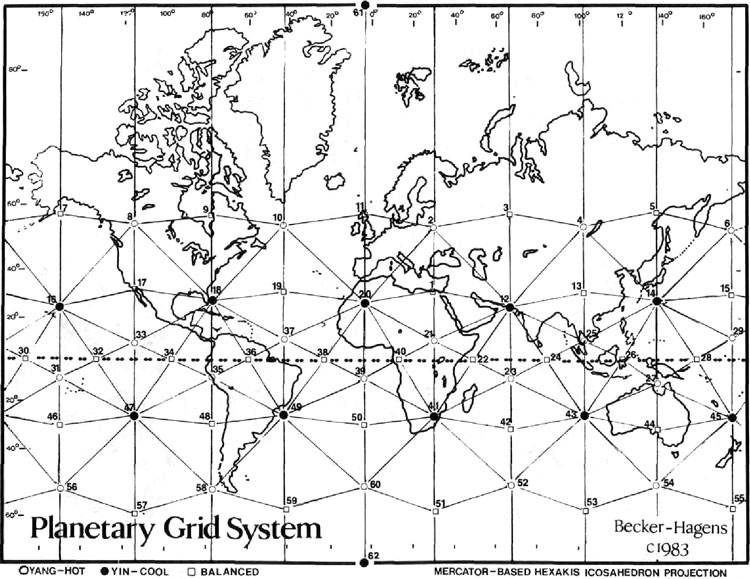Post by Ophiuchus on Oct 8, 2011 20:20:26 GMT -6
Ley Lines

Ley lines are alleged alignments of a number of places of geographical interest, such as ancient monuments and megaliths, natural ridge-tops and water-fords. Their existence was suggested in 1921 by the amateur archaeologist Alfred Watkins, in his books Early British Trackways and The Old Straight Track. Watkins theorized that these alignments were created for ease of overland trekking by line of sight navigationNavigationNavigation is the process of monitoring and controlling the movement of a craft or vehicle from one place to another. It is also the term of art used for the specialized knowledge used by navigators to perform navigation tasks...
during neolithic times and had persisted in the landscape over millennia. In more recent times, the term ley lines has come to be associated with spiritual and mystical theories about land forms, including Chinese feng shui.
Alfred Watkins and The Old Straight Track
The concept of "ley lines" is generally thought of in relation to Alfred Watkins, but the stimulus and background for the concept is attributed to the English astronomer Norman Lockyer. On 30 June 1921, Watkins visited Blackwardine in Herefordshire, and went riding a horse near some hills in the vicinity of Bredwardine, when he noted that many of the footpaths there seemed to connect one hilltop to another in a straight line. He was studying a map when he noticed places in alignment. "The whole thing came to me in a flash", he later told his son. It has been suggested that Watkins' experience stemmed from faint memories of an account in September 1870 by William Henry Black given to the British Archaeological Association in Hereford titled Boundaries and Landmarks, in which he speculated that "Monuments exist marking grand geometrical lines which cover the whole of Western Europe".
Watkins believed that, in ancient times, when Britain was far more densely forested, the country was criss-crossed by a network of straight-line travel routes, with prominent features of the landscape being used as navigation points. This observation was made public at a meeting of the Woolhope Naturalists of Hereford in September 1921. His work referred to G. H. Piper's paper presented to the Woolhope Club in 1882, which noted that: "A line drawn from the Skirrid-fawrYsgyryd mountain northwards to Arthur's Stone would pass over the camp and southern most point of Hatterall Hill, Oldcastle Monmouthshire- Longtown Castle, and Urishay and Snodhill castles." The ancient surveyors who supposedly made the lines were given the name "dodmen". He believed that the lines themselves had been called "leys" because so many of them passed through locations whose names included the element "ley", stating that philologists defined the word (spelled also as lay, lea, lee, or leigh) differently but had misinterpreted it.
Examples of ley lines in Britain
Alfred Watkins identified St. Ann's Well in Worcestershire as what he believed to be the start of a ley line that passes along the ridge of the Malvern Hills through several springs including the Holy Well, Walms Well and St. Pewtress Well.
In the late 1970s Paul Devereux stated he had discovered the “Malvern Ley” which began at St Ann's Well and ended at Whiteleaved Oak. The alignment passes through St. Ann's Well, the Wyche Cutting, a section of the Shire Ditch, Midsummer hillfort and Whiteleaved Oak.
Criticisms of the ley line hypothesis
Watkins' work met with early scepticism from archaeologists, one of whom, O. G. S. Crawford, refused to accept advertisements for The Old Straight Track in the journal Antiquity.

In recent years, refutations of Watkins' ideas have been generally based on mathematical models.
Chance alignments
One criticism of Watkins' ley line theory states that given the high density of historic and prehistoric sites in Britain and other parts of Europe, finding straight lines that "connect" sites is trivial , and ascribable to coincidence. A statistical analysis of lines concluded that "the density of archaeological sites in the British landscape is so great that a line drawn through virtually anywhere will 'clip' a number of sites."
Shape analysis
A study by David George Kendall used the techniques of shape analysis to examine the triangles formed by standing stones to deduce if these were often arranged in straight lines. The shape of a triangle can be represented as a point on the sphere, and the distribution of all shapes can be thought of as a distribution over the sphere. The sample distribution from the standing stones was compared with the theoretical distribution to show that the occurrence of straight lines was no more than average.
Archaeologist Richard Atkinson once demonstrated this by taking the positions of telephone boxes and pointing out the existence of "telephone box leys". This, he thus argued, showed that the mere existence of such lines in a set of points does not prove that the lines are deliberate artefacts, especially since it is known that telephone boxes were not laid out in any such manner, and without any such intention.
Attribution of spiritual significance to ley lines
In 1969, the British author John Michell, who had previously written on the subject of UFOs, published The View Over Atlantis, in which he revived Watkins' ley line theories and linked them with the Chinese concept of feng shui.
The book, published by Sago Press, proved popular and was reprinted in Great Britain by Garnstone Press in 1972 and Abacus in 1973, and in the United States by Ballantine Books in 1972. Gary Lachman states that The View Over Atlantis "put Glastonbury on the countercultural map." Ronald Hutton describes it as "almost the founding document of the modern earth mysteries movement".
Following after Michell's success at mingling Watkins' amateur archaeology with Chinese spiritual concepts of land-forms, the 1970s saw many newly emerging theories about the alignments of monuments and natural landscape features by writers who made use of Watkins' terminology in service of concepts related to dowsing and New Age beliefs, including the idea that ley lines have spiritual power or that ley lines and their intersection points resonate a special psychic or mystical energy.
Ascribing such characteristics to ley lines has led to the term being classified as pseudoscience.
In 2004, John Bruno Hare wrote:
Watkins never attributed any supernatural significance to leys; he believed that they were simply pathways that had been used for trade or ceremonial purposes, very ancient in origin, possibly dating back to the Neolithic, certainly pre-Roman. His obsession with leys was a natural outgrowth of his interest in landscape photography and love of the British countryside. He was an intensely rational person with an active intellect, and I think he would be a bit disappointed with some of the fringe aspects of ley lines today".
Cultural references
Ley lines appear in various works (both novels and short stories) of fantasy. In the Darkness series by Harry Turtledove, leylines are used for transportation by ships and trains that harness the planet's magical force. They also allow mages to cast more powerful magic. In the Vampire Diaries book series by L. J. Smith
L. J. Smith, a large number of leylines converge under the graveyard and the Old Wood of Fell's Church. In these books, they allow supernatural forces to become more powerful, and also attract magic.


Ley lines are alleged alignments of a number of places of geographical interest, such as ancient monuments and megaliths, natural ridge-tops and water-fords. Their existence was suggested in 1921 by the amateur archaeologist Alfred Watkins, in his books Early British Trackways and The Old Straight Track. Watkins theorized that these alignments were created for ease of overland trekking by line of sight navigationNavigationNavigation is the process of monitoring and controlling the movement of a craft or vehicle from one place to another. It is also the term of art used for the specialized knowledge used by navigators to perform navigation tasks...
during neolithic times and had persisted in the landscape over millennia. In more recent times, the term ley lines has come to be associated with spiritual and mystical theories about land forms, including Chinese feng shui.
Alfred Watkins and The Old Straight Track
The concept of "ley lines" is generally thought of in relation to Alfred Watkins, but the stimulus and background for the concept is attributed to the English astronomer Norman Lockyer. On 30 June 1921, Watkins visited Blackwardine in Herefordshire, and went riding a horse near some hills in the vicinity of Bredwardine, when he noted that many of the footpaths there seemed to connect one hilltop to another in a straight line. He was studying a map when he noticed places in alignment. "The whole thing came to me in a flash", he later told his son. It has been suggested that Watkins' experience stemmed from faint memories of an account in September 1870 by William Henry Black given to the British Archaeological Association in Hereford titled Boundaries and Landmarks, in which he speculated that "Monuments exist marking grand geometrical lines which cover the whole of Western Europe".
Watkins believed that, in ancient times, when Britain was far more densely forested, the country was criss-crossed by a network of straight-line travel routes, with prominent features of the landscape being used as navigation points. This observation was made public at a meeting of the Woolhope Naturalists of Hereford in September 1921. His work referred to G. H. Piper's paper presented to the Woolhope Club in 1882, which noted that: "A line drawn from the Skirrid-fawrYsgyryd mountain northwards to Arthur's Stone would pass over the camp and southern most point of Hatterall Hill, Oldcastle Monmouthshire- Longtown Castle, and Urishay and Snodhill castles." The ancient surveyors who supposedly made the lines were given the name "dodmen". He believed that the lines themselves had been called "leys" because so many of them passed through locations whose names included the element "ley", stating that philologists defined the word (spelled also as lay, lea, lee, or leigh) differently but had misinterpreted it.
Examples of ley lines in Britain
Alfred Watkins identified St. Ann's Well in Worcestershire as what he believed to be the start of a ley line that passes along the ridge of the Malvern Hills through several springs including the Holy Well, Walms Well and St. Pewtress Well.
In the late 1970s Paul Devereux stated he had discovered the “Malvern Ley” which began at St Ann's Well and ended at Whiteleaved Oak. The alignment passes through St. Ann's Well, the Wyche Cutting, a section of the Shire Ditch, Midsummer hillfort and Whiteleaved Oak.
Criticisms of the ley line hypothesis
Watkins' work met with early scepticism from archaeologists, one of whom, O. G. S. Crawford, refused to accept advertisements for The Old Straight Track in the journal Antiquity.

In recent years, refutations of Watkins' ideas have been generally based on mathematical models.
Chance alignments
One criticism of Watkins' ley line theory states that given the high density of historic and prehistoric sites in Britain and other parts of Europe, finding straight lines that "connect" sites is trivial , and ascribable to coincidence. A statistical analysis of lines concluded that "the density of archaeological sites in the British landscape is so great that a line drawn through virtually anywhere will 'clip' a number of sites."
Shape analysis
A study by David George Kendall used the techniques of shape analysis to examine the triangles formed by standing stones to deduce if these were often arranged in straight lines. The shape of a triangle can be represented as a point on the sphere, and the distribution of all shapes can be thought of as a distribution over the sphere. The sample distribution from the standing stones was compared with the theoretical distribution to show that the occurrence of straight lines was no more than average.
Archaeologist Richard Atkinson once demonstrated this by taking the positions of telephone boxes and pointing out the existence of "telephone box leys". This, he thus argued, showed that the mere existence of such lines in a set of points does not prove that the lines are deliberate artefacts, especially since it is known that telephone boxes were not laid out in any such manner, and without any such intention.
Attribution of spiritual significance to ley lines
In 1969, the British author John Michell, who had previously written on the subject of UFOs, published The View Over Atlantis, in which he revived Watkins' ley line theories and linked them with the Chinese concept of feng shui.
The book, published by Sago Press, proved popular and was reprinted in Great Britain by Garnstone Press in 1972 and Abacus in 1973, and in the United States by Ballantine Books in 1972. Gary Lachman states that The View Over Atlantis "put Glastonbury on the countercultural map." Ronald Hutton describes it as "almost the founding document of the modern earth mysteries movement".
Following after Michell's success at mingling Watkins' amateur archaeology with Chinese spiritual concepts of land-forms, the 1970s saw many newly emerging theories about the alignments of monuments and natural landscape features by writers who made use of Watkins' terminology in service of concepts related to dowsing and New Age beliefs, including the idea that ley lines have spiritual power or that ley lines and their intersection points resonate a special psychic or mystical energy.
Ascribing such characteristics to ley lines has led to the term being classified as pseudoscience.
In 2004, John Bruno Hare wrote:
Watkins never attributed any supernatural significance to leys; he believed that they were simply pathways that had been used for trade or ceremonial purposes, very ancient in origin, possibly dating back to the Neolithic, certainly pre-Roman. His obsession with leys was a natural outgrowth of his interest in landscape photography and love of the British countryside. He was an intensely rational person with an active intellect, and I think he would be a bit disappointed with some of the fringe aspects of ley lines today".
Cultural references
Ley lines appear in various works (both novels and short stories) of fantasy. In the Darkness series by Harry Turtledove, leylines are used for transportation by ships and trains that harness the planet's magical force. They also allow mages to cast more powerful magic. In the Vampire Diaries book series by L. J. Smith
L. J. Smith, a large number of leylines converge under the graveyard and the Old Wood of Fell's Church. In these books, they allow supernatural forces to become more powerful, and also attract magic.







